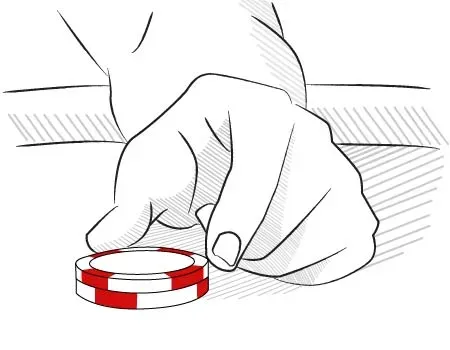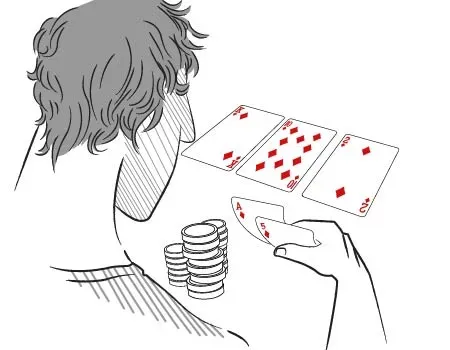POKER BLUFFING TIPS
Because there are so many variables to the game of poker (hole cards, board textures, stack sizes, table positions, your opponents’ tendencies, your opponents table positions, game dynamics, etc.) - each hand you’re dealt in poker truly is a unique situation.
The following is a list of miscellaneous bluffing tips aimed at giving you additional considerations to think about when bluffing – beyond the major concepts that have already been discussed in this book.
THE BEST POKER BLUFFING TIPS ARE:
- Know that small bluffs counts
- Balance Your Ranges and Plays
- Abandon the Bluff, If Necessary
- Notice your polarised Ranges
- Look for Signs of Weakness
- Have Some Equity
- Make semi-bluffs when necessary
- Risk the Minimum
- Remember to Use Your Hole Cards as Information
- Bluffing Is Mandatory in The Right Spots
- Try to Satisfy as Many Conditions for A “Good Time to Bluff”
- It’s Okay to Lose with Bluffs
- Improve Your Hand-Reading Abilities
-
Tip 1: Know that small bluffs counts. Don’t be under the illusion that all bluffs must be grandiose, multi-street, barrelling contests. Even a cbet less than ½ the size of the pot can be an effective bluff. Smaller 3bets when in position preflop can also be used for cbets in your 3bet pots. While larger-sized bets usually increase your amount of fold equity, not every situation requires a large bluff bet. Betting small as a bluff on earlier streets can also help you gain information and more fold equity for later streets, if you choose to put in a bigger bet at such times.

- Tip 2: Balance Your Ranges and Plays: It’s important to balance your ranges and bets to keep your opponents guessing as to what your hand range is (nuts, value, marginal, or bluff) at all times. Essentially, this means that you shouldn’t play your value hands the same way every time, nor should you bluff the same way every time, either. Doing this makes you a much more dangerous opponent to play against, as you’re much less predictable.
- Tip 3: Abandon the Bluff, If Necessary: Don’t fall into the trap of deciding to bluff three streets, and then overcommitting in following through when the turn and river create bad situations for your range and/or good ones for that of your opponents.
- Tip 4: Notice your polarised Ranges: A polarised hand range is one that involves both the top and bottom of your range and nothing else in between. For example, if you overbet $200 into a pot of $100 on the river, this bet is a polarised bet, which means you either have a really, really strong hand or absolutely nothing (i.e. you know your opponent’s beating you). Sometimes making a bet that polarises your range can be very effective when you know your opponent couldn’t risk calling a bet of a certain size with a marginal holding like you think he or she is likely to have.
- Tip 5: Look for Signs of Weakness: Adding on to the last point, if you can conclude that your opponent has a weak or marginal holding and you can logically represent a value-type hand in that situation, you can then effectively capitalise on this by applying pressure on your opponent with a bluff. Signs of weakness may include physical poker tells, bet timing tells, verbal tells, or betting tells.

- Tip 6: Have Some Equity: If all the money is going in on the flop or turn (i.e. for those situations where there’s one or more community cards that still need to be dealt), if you are choosing to bluff with the remainder of your stack, it’s usually best to at least some Or, at least have a chance of improving to a hand better than what you put your opponent on.
- Tip 7: Make semi-bluffs when necessary. While we will dedicate a later section of this book entirely to the concept of semi-bluffs, it’s important to bring it up briefly in this section, as well. Put simply; a semi-bluff is where you bet while your hand doesn’t have much current value but has the potential of improving. (A common semi-bluff is (1) betting with a flush draw, or (2) simply cbetting with two overcards.) If you can, mix semi-bluffs into your game to go along with your bluffs and value bets, you’ve then added yet another powerful tool to your poker arsenal.
- Tip 8: Risk the Minimum: Always remember that while you want to gain fold equity with your bluffs, it’s always important to risk the minimum when doing this so that you aren’t losing more money than necessary during the times that you are called.
- Tip 9: Remember to Use Your Hole Cards as Information: Sometimes you can use the cards in your hand as information to know what cards your opponent does not For example, let’s say after the river, there are three Spades on an unpaired board and your opponent bets into you. While you don’t have a flush yourself, you are holding the Ace of Spades, which means, as long as there aren’t straight-flush possibilities for your opponent to have, then you’re opponent, certainly, does not have the best possible hand. In these situations, if enough criteria for attempting a bluff are met, it might sometimes be profitable to raise and represent the nut flush, if you think your opponent is capable of folding his range of hands in such a circumstance.

- Tip 10: Bluffing Is Mandatory in The Right Spots: Bluffing isn’t necessarily a choice; it’s mandatory when the right situation comes along and demands it. Just as you would almost always bet your strong hands if your opponent checks to you on the river, if the right situation comes along for you to bluff, take full advantage and make a stab at the pot! Worst case scenario: you learn from your mistakes and live to play another hand!
- Tip 11: Try to Satisfy as Many Conditions for A “Good Time to Bluff”: Your bluffs will be more effective if all the right criteria are met before attempting them. Don’t pick inopportune times to arbitrarily bluff; wait for the right moments, and then capitalise on your opponent’s weakness.
- Tip 12: It’s Okay to Lose with Bluffs: Don’t worry about all your bluffs being successful or not! Remember the “breakeven percentage” we talked about in the last section? As long as our bluffs generate folds enough times, then our bluffs will be profitable over the long term.
- Tip 13: Improve Your Hand-Reading Abilities: To be good at poker, it’s so important to improve your hand-reading abilities. Take all the information you have available to you (from player tendencies to player statistics to betting tells and more) to create a hand range for what you think your opponent could have in a specific spot. The better this range is that you give your opponent, the better you can counteract their play and determine accordingly when you should bluff or value bet against them. With these increased abilities and higher mental processes, you can also begin to consider what you think your opponent thinks you have, and vice versa, which will ultimately all bring your game to a higher level.
